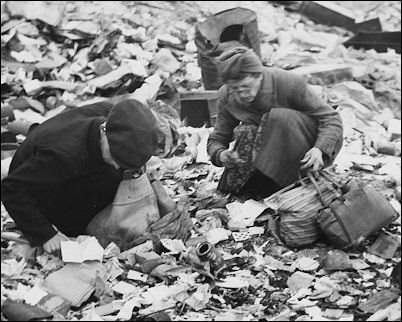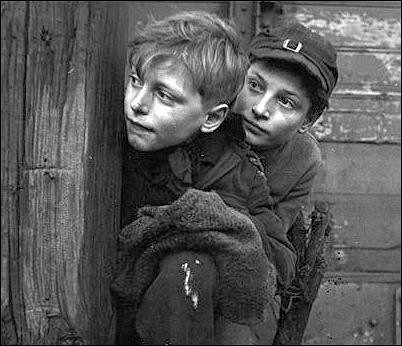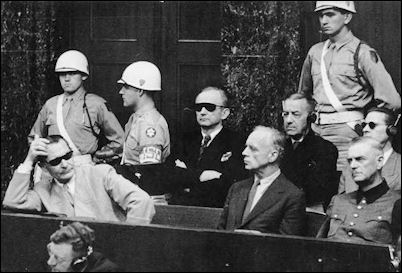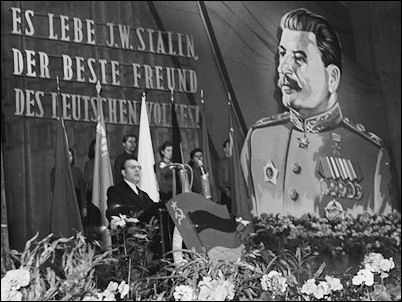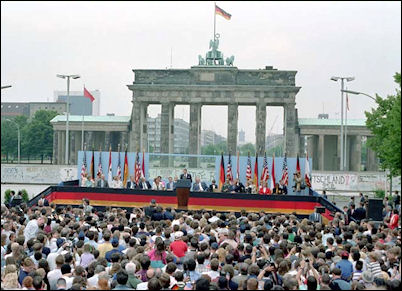![]()

Aftermath: Nuremberg and Beyond
Germany, much of Europe and Russia lay in ruins following Hitler's war, the most destructive conflict in the history of humanity, in which 54 million persons had perished – with more civilians killed than combatants – while another 60 million civilians had been uprooted from their homes or seen them destroyed.
The immediate postwar problem for the victorious Allies in Germany was coping with the eleven million displaced persons (DPs) now wandering around. This included people from all over Europe and Russia who had been slave laborers, military conscripts, prisoners of war, and concentration camp inmates, including about 100,000 Jews who had survived the Final Solution.
Upon regaining their health, many of the Jews returned home, trying in vain to locate family members. In some cases, they found former neighbors now inhabiting their homes and shops. The new occupants soon made it clear they wished the Jews had never returned. Elsewhere, particularly in Eastern Europe, people lashed out at the returning Jews and hundreds were killed. As a result, the displaced Jews headed back to Germany and took refuge in American DP Camps, while they considered leaving Europe altogether and relocating to the historic Jewish homeland in the Middle East, an epic saga that would eventually lead to the founding of Israel.
Along with the DP problem, another great concern for the victors in Germany was that Hitlerism, in some form or other, would linger among the German population, with resulting hostility and violence. However, it soon became apparent that the death of Hitler had brought an abrupt and absolute end to the Nazi era. Most Germans were now overwhelmingly concerned with the basics of life – food, water and a safe place to sleep.
Nevertheless, as a precaution, all semblances of German authority, down to the local traffic cop, were dissolved by the victors, and the conquered Germans were ruled entirely by American, British, French and Russian military personnel. The German nation was accordingly split into four occupation zones. The western portion of Germany was placed under American, British and French jurisdiction, while the eastern portion came under the control of Soviet Russia. Berlin, the former Nazi capital, was located inside the Russian zone, but was still divided into four zones.
Adapting to life among the ruins, Germans who had never shown mercy to anyone now found themselves utterly dependent on the mercy of their conquerors. They meekly accepted food handouts, blankets, or anything else available. German boys, who had learned survival tactics in the Hitler Youth, now devoted their energy to becoming efficient scroungers, constantly searching for bits of coal or wood for the kitchen stove. And they delighted in stealing food, chocolate, cigarettes, or other valuables from the well-supplied Americans.
Although U.S. troops were regarded as the friendliest of the conquerors, American troops had nevertheless made it a practice of forcing local townspeople and ex-Hitler Youth members to view the carnage inside liberated concentration camps. In some places they were even forced to help bury corpses. Elsewhere, German boys and girls were eventually required to attend local theaters and watch Allied educational films concerning the camps.
General Eisenhower himself had insisted that a filmed record be made, upon visiting Ohrdruf, a sub-camp of Buchenwald in central Germany. After walking among the bodies and listening to the harrowing accounts of survivors, Eisenhower said he believed people would someday deny that such things ever happened.
The scope of the concentration camp system, persecutions and mass shootings by Nazis throughout Europe and Russia, gave rise to the question of justice as soon as the war ended. For those involved in the crimes, the first inkling there would be a reckoning came when the SS, formerly Hitler's most elite security service, was declared a criminal organization by the victors.
All over Germany, surviving Nazi leaders were hunted down and taken into custody. Among those captured were Hermann Göring, ex-Foreign Minister Joachim Ribbentrop, Field Marshal Keitel, General Jodl, and Hans Frank, one-time Governor-General of Poland. Heinrich Himmler, perhaps the most notorious Nazi after Hitler, had killed himself by ingesting poison while in British custody.
Remarkably, just six months after the war ended, the Allies were ready to prosecute. Beginning on Tuesday, November 20, 1945, twenty-one of the highest-ranking Nazis went on trial in Nuremberg. The unprecedented four-count indictment included: Conspiracy to Wage Aggressive War; Crimes Against Peace; War Crimes; and Crimes Against Humanity – encompassing extermination, enslavement, persecution on political or racial grounds, involuntary resettlement, and inhumane acts against civilian populations.
The trial was conducted by a joint United States-British-French-Russian military tribunal, with British Justice, Geoffrey Lawrence, presiding. American journalist, William Shirer, who had spent several years as a correspondent stationed in Nazi Germany, attended the trial's beginning and gazed upon the defendants: “I had often watched them in their hour of glory and power at the annual Party rallies in this town. In the dock before the International Military Tribunal they looked different. There had been quite a metamorphosis. Attired in rather shabby clothes, slumped in their seats fidgeting nervously, they no longer resembled the arrogant leaders of old. They seemed to be a drab assortment of mediocrities. It seemed difficult to grasp that such men, when you had last seen them, had wielded such monstrous power, that men such as they could conquer a great nation and most of Europe.”
A principle goal of the trial, as British Prosecutor, Hartley Shawcross, later recounted, was "to lay down the rules of International Law for the future, not only making the waging of aggressive war unlawful, but for the first time, making the statesmen who led their countries into an aggressive war personally responsible for what they had done."
The defendants, all of whom pleaded not guilty, were allowed to choose any lawyer they wanted. Therefore some of Germany's best defense attorneys, including unrepentant Nazis, were present in the courtroom. At first, they attacked the very premise of the trial, arguing there was no legal precedent for charging their clients for the alleged crimes of the Nazi State, including waging aggressive war. The Tribunal responded: "The very idea that States commit crimes is a fiction. Crimes are always committed by persons. Men who exercised great power can not be allowed to shift their responsibility on the fictional State which can not be produced for trial."
As the prosecution began its case, American lead Prosecutor, Robert Jackson, focused exclusively on the thousands of incriminating Nazi documents that Allied investigators had assembled. This evidence provided the first behind-the-scenes glimpse of the Nazi regime, uncovering the diplomatic maneuvers and military tactics used to intimidate Europe's political leaders into submission before the war, and the steps taken to prepare Germany for a war of conquest.
Nazi propaganda films showing Hitler during his days of triumph were subsequently presented in support of the written evidence. An unexpected side effect was that the defendants were genuinely elated by the presence of their Führer in the courtroom, if only on film. A touch of the old Nazi arrogance even resurfaced among some of the defendants for all in the courtroom to see.
However, this changed abruptly when the prosecution shifted its focus to the Final Solution, presenting testimony by key participants including SS-Einsatz group leader, Otto Ohlendorf, who admitted the killing of 90,000 persons, and Auschwitz Commandant, Rudolf Höss, who estimated the killing of 2.5 million.
The human impact of those admissions was brought home when German businessman, Hermann Graebe, took the witness stand and described what he saw after accidentally stumbling upon an Einsatz unit in Lithuania: "An old woman with snow white hair was holding a one-year-old child in her arms and singing to it and tickling it. The child was cooing with delight. The parents were looking on with tears in their eyes. The father was holding the hand of a boy about ten years old and speaking to him softly; the boy was fighting his tears. The father pointed to the sky, stroked his head and seemed to explain something to him. At that moment the SS man at the pit started shouting something to his comrade. The latter counted off about twenty persons and instructed them to go behind the earth mound. Among them was the family I have just mentioned..."
Next came the showing of a documentary compiled by Hollywood film director George Stevens, who had accompanied U.S. troops from D-Day onward. Entitled "Nazi Concentration Camps," the two-hour-long film showed what the Allies had found upon liberating the camps, and included scenes of a bulldozer pushing piles of bodies into a mass grave at Bergen-Belsen. The film had a devastating effect on the defendants, shocking them with irrefutable evidence of the atrocities of their regime. Most could only watch part of the film, and either turned away from the movie screen or gazed at the floor while hanging their heads low.
Although the atmosphere in the courtroom had changed dramatically, the Allies were determined to the utmost to conduct a fair trial. Therefore when it came time for the defense portion of the trial, they allowed defendants such as Göring to speak uninterrupted while on the witness stand. This suited the egotistical, quick-witted Göring well, and over nine continuous days he frustrated all attempts by Prosecutor Jackson and others to get him to admit any fault. The other defendants now looked to Göring as their leader. They were bolstered by the ex-Reich Marshal's lengthy, defiant discourses defending himself, his Führer and the Nazi regime. Defendant Rudolf Hess, who had aided Hitler during his rise to power, was so impressed with Göring, at one point he whispered to him, "You will yet be Führer of Germany."
But not all of the defendants stuck by Göring. The first to break away and express remorse was Albert Speer, the former Minister of Armaments who had relied on slave labor for war production. Hans Frank, a catalyst of the Final Solution, rediscovered his Christianity and was overcome with remorse. Ex-Hitler Youth Leader, Baldur von Schirach, bitterly denounced Hitler and labeled Auschwitz as "the most devilish mass murder in history."
The trial, which lasted 315 days, ended upon the pronouncement of sentences by the Tribunal Judges on Tuesday, October 1st, 1946. Eleven defendants were sentenced to death by hanging, including Görng, Ribbentrop, Hans Frank, Keitel and Jodl. Three got life sentences, including Rudolf Hess. Schirach and Speer got twenty years. Karl Dönitz got ten years. Three were acquitted, including Franz von Papen, who had helped Hitler come to power in 1933, but later wound up in a concentration camp himself.
In the early morning hours of Wednesday, October 16, 1946, Ribbentrop was hanged first, followed by Keitel and the others, ending with Jodl. Göring avoided hanging by swallowing cyanide poison somehow smuggled into his prison cell that day. The bodies were all burned in the crematory at Dachau, and the ashes were scattered into a nearby river.
Outside the courtroom and throughout Germany, people hardly took notice of the fate of their once-vaunted leaders, much to the relief of the Allies who had been concerned about a possible backlash.
Twelve additional Nuremberg trials were held from 1946-49, presided by American judges. The Doctors’ Trial targeted SS doctors who ran euthanasia centers to kill sick and disabled Germans, including 5,000 children. Also targeted were leaders of the Einsatz killing squads and pro-Nazi corporate leaders who had profited from slave labor.
But with the passage of time and changing international politics, interest in such trials diminished. Many of the convictions were voided in 1951, and Nazi war criminals were set free, when a liberal pardon policy went into effect. Overall, only a small percentage of those involved in implementing the Final Solution or directing Hitler’s war of aggression were ever brought to justice.
After the war, the influence of Great Britain and France declined on the world stage as two new Superpowers emerged – the United States and Soviet Russia. The wartime alliance between America and Russia withered after Hitler’s defeat, then dissolved into a long era of mutual mistrust known as the Cold War. Postwar Germany found itself squarely in the middle of the Cold War, literally divided between the two Superpowers.
The Russian-occupied zone in eastern Germany became known as the German Democratic Republic, a Communist satellite dominated by Stalin and the Soviet Union. In western Germany, the zones occupied by America, Britain and France became an independent democratic nation, the Federal Republic of Germany, staunchly allied with the United States, which poured in billions of dollars in aid to help it rebuild.
The demise of Soviet Russia in the late 1980s gave the Germans an opportunity to reunite their country after four decades of separation. From 1990 onward, reunified Germany has maintained a steadfast commitment to democracy while struggling with the economic stresses brought on by merging wealthier West Germans with their much poorer Eastern neighbors. At the same time, Germany has struggled to cope with tensions resulting from a significant influx of non-European immigrants.
The beginning of the 21st Century saw the gradual passing of the generation of Germans who either participated in, or witnessed, the Nazi reign of terror. Although the perpetrators have mostly departed, the mentality that propelled them to murderous action – racial hatred, lust for power, and greed – remains an unsolved human problem that has plagued the world from dawn of civilization, providing ample opportunity for aspiring tyrants and is an ever-present danger.
Copyright © 2010 The History Place™ All Rights Reserved
![]()
Author/Bibliography
The Defeat of Hitler Index
The History Place Main Index Page
Terms of use: Private home/school non-commercial, non-Internet re-usage only is allowed of any text, graphics, photos, audio clips, other electronic files or materials from The History Place.
